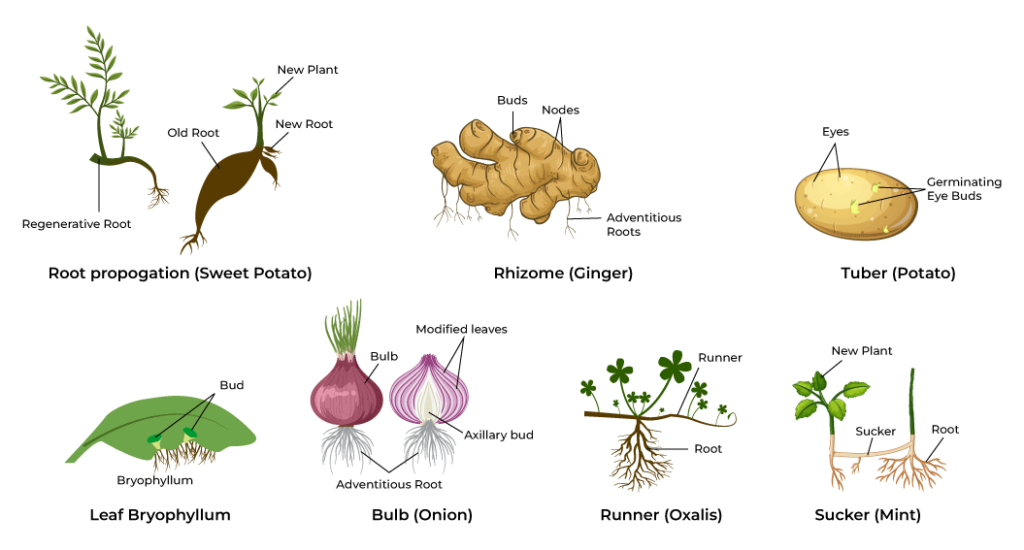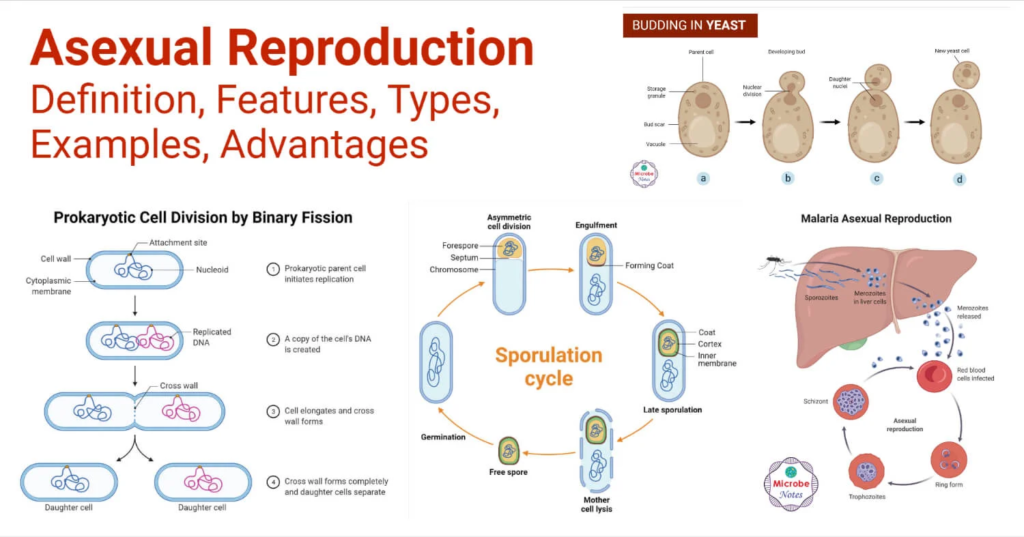Interesting way to Learn Bio with Syeda: Reproduction
CHAPTER 14
Reproduction
Introduction of Reproduction:
Reproduction is the biological process by which new individual organisms are produced. It is essential for species’ survival and involves two main types: asexual and sexual reproduction.
1. Types of Reproduction
Asexual Reproduction:
- Involves a single parent.
- Offspring are genetically identical to the parent (clones).
- Common in single-celled organisms and some plants and animals.
- Methods include:
- Binary Fission: Simple cell division in bacteria and protists.
- Budding: A new organism develops from an outgrowth or bud (e.g., yeast, hydra).
- Fragmentation: The organism splits into fragments, each capable of growing into a new organism (e.g., starfish).
- Vegetative Propagation: New plants grow from parts of the parent plant (e.g., runners in strawberries).
Sexual Reproduction:
- Involves two parents (male and female).
- Offspring have genetic material from both parents, resulting in genetic variation.
- Common in most animals and plants.
- Involves the formation of gametes (sperm and egg) through meiosis.
- Fertilization occurs when the sperm and egg unite to form a zygote.
2. Human Reproductive System
Male Reproductive System:
- Testes: Produce sperm and testosterone.
- Epididymis: Stores sperm.
- Vas Deferens: Transports sperm from the epididymis to the urethra.
- Seminal Vesicles and Prostate Gland: Produce seminal fluid to nourish and transport sperm.
- Penis: Delivers sperm into the female reproductive tract.
Female Reproductive System:
- Ovaries: Produce eggs (ova) and hormones (estrogen and progesterone).
- Fallopian Tubes: Transport the egg from the ovary to the uterus; the site of fertilization.
- Uterus: Nurtures the developing fetus.
- Vagina: Receives sperm during intercourse and serves as the birth canal.
3. Menstrual Cycle
- The menstrual cycle is a monthly process in females that prepares the body for pregnancy.
- It involves the thickening of the uterine lining, ovulation (release of an egg), and, if fertilization does not occur, shedding of the uterine lining (menstruation).
4. Fertilization and Development
- Fertilization: The fusion of a sperm and egg to form a zygote.
- Embryonic Development: The zygote undergoes multiple cell divisions to form an embryo, which implants in the uterine wall.
- Fetal Development: The embryo develops into a fetus, which grows and matures until birth.
5. Importance of Reproduction
- Ensures the continuation of species.
- Introduces genetic variation, which is essential for evolution and adaptation to changing environments.
By understanding these fundamental concepts of reproduction, you gain insight into the biological processes that sustain life and ensure the diversity and survival of species.
UNDERSTANDING THE CONCEPT
1. Give an introduction to Pakistan’s National AIDS Control Program.
Pakistan’s National AIDS Control Program (NACP) is an initiative established to control and prevent the spread of HIV/AIDS in the country. The program focuses on awareness, prevention, treatment, and care services. Key aspects include:
- Awareness Campaigns: Educating the public about HIV/AIDS transmission and prevention.
- Testing and Diagnosis: Providing facilities for HIV testing and early diagnosis.
- Treatment: Offering antiretroviral therapy (ART) to those diagnosed with HIV.
- Support Services: Assisting patients with counseling, healthcare, and reducing stigma.
- Targeted Interventions: Focusing on high-risk groups such as intravenous drug users, sex workers, and men who have sex with men (MSM).
2. What are the different ways by which prokaryotes, protozoans, and fungi reproduce asexually?
Prokaryotes (e.g., bacteria):

- Binary Fission: The cell divides into two identical daughter cells. The DNA replicates, and the cell splits into two.
Protozoans (e.g., amoebas, paramecia):

- Binary Fission: Like prokaryotes, the cell splits into two equal parts.
- Budding: A new organism develops from a small outgrowth or bud on the parent.
- Schizogony: Multiple fission where the nucleus divides several times before the cell splits into many new cells.
Fungi (e.g., molds, yeasts):

- Spore Formation: Spores are produced and released into the environment; they germinate into new fungi.
- Budding: Common in yeasts, where a new cell forms as a bud on the parent cell.
- Fragmentation: The mycelium (body) breaks into fragments, each capable of growing into a new organism.
3. Explain the different parts of the plant that help in natural vegetative propagation.

Natural Vegetative Propagation:
- Stems: Runners (stolons) in strawberries, rhizomes in ginger, and tubers in potatoes.
- Roots: Tubers in sweet potatoes, suckers in dandelions.
- Leaves: Bryophyllum plants where new plants grow from the edges of leaves.
- Bulbs: Onion and garlic, where underground bulbs produce new plants.
4. Explain how the epigeal and hypogeal germinations are different.

Epigeal Germination:
- The cotyledons (seed leaves) are pushed above the ground as the seedling grows.
- Example: Beans and castor plants.
- The hypocotyl (part of the stem below the cotyledons) elongates and raises the cotyledons above the soil.
Hypogeal Germination:
- The cotyledons remain below the ground.
- Example: Peas and maize.
- The epicotyl (part of the stem above the cotyledons) elongates, and the shoot emerges above the soil.
5. What conditions are necessary for the germination of seeds?

Conditions Necessary for Germination:
- Water: Activates enzymes and swells the seed, breaking the seed coat.
- Oxygen: Essential for cellular respiration to provide energy for growth.
- Temperature: Optimal range for enzyme activity and seedling development (varies for different species).
- Light: Some seeds require light for germination (photoblastic seeds), while others do not.
6. Outline the methods of asexual reproduction in animals.

Methods of Asexual Reproduction in Animals:
- Binary Fission: Division of a single organism into two parts (e.g., amoebas).
- Budding: New individuals grow from the body of the parent (e.g., hydra, yeasts).
- Fragmentation: The body breaks into pieces, each developing into a new organism (e.g., starfish, planarians).
- Parthenogenesis: Development of an egg without fertilization (e.g., some insects, reptiles).
7. Write a note on rabbits’ male and female reproductive systems.
Male Reproductive System:
- Testes: Produce sperm and testosterone.
- Epididymis: Stores and matures sperm.
- Vas Deferens: Transports sperm to the urethra.
- Penis: Delivers sperm into the female reproductive tract.
Female Reproductive System:
- Ovaries: Produce eggs and hormones (estrogen and progesterone).
- Fallopian Tubes: Transport eggs from the ovaries to the uterus.
- Uterus: Site of implantation and development of the embryo.
- Vagina: Receives sperm during mating and serves as the birth canal.
8. Describe the processes of spermatogenesis and oogenesis.

Spermatogenesis:
- Occurs in the testes.
- Involves the formation of sperm from spermatogonia.
- Process: Spermatogonia (2n) → Primary spermatocytes (2n) → Secondary spermatocytes (n) → Spermatids (n) → Sperm (n).
- Continuous process producing millions of sperm daily.
Oogenesis:
- Occurs in the ovaries.
- Involves the formation of eggs from oogonia.
- Process: Oogonia (2n) → Primary oocytes (2n) → Secondary oocyte (n) and first polar body (n) → Ovum (n) and second polar body (n) (upon fertilization).
- Produces one mature ovum per menstrual cycle.
9. Why do we consider that overpopulation is a global problem?
Overpopulation as a Global Problem:
- Resource Depletion: Increased demand for food, water, and energy strains resources.
- Environmental Impact: More waste, pollution, and habitat destruction.
- Economic Strain: Increased demand for jobs, healthcare, and education.
- Social Issues: Overcrowding, increased poverty, and decreased quality of life.
- Health Concerns: Greater spread of diseases and insufficient healthcare services.
SHORT QUESTIONS
1. How are the natural and artificial vegetative propagations the methods of asexual reproduction in plants?
Natural Vegetative Propagation:
- Natural vegetative propagation occurs without human intervention.
- Involves parts of the plant such as stems, roots, or leaves developing into new plants.
- Examples include runners in strawberries, tubers in potatoes, and bulbs in onions.
Artificial Vegetative Propagation:
- Artificial vegetative propagation involves human techniques to grow new plants.
- Methods include cutting, grafting, layering, and tissue culture.
- These methods ensure desired traits and rapid multiplication of plants.
Both natural and artificial vegetative propagation produce genetically identical offspring to the parent plant, classifying them as methods of asexual reproduction.
2. Why do gardeners use the methods of cutting and grafting?
Cutting:
- Involves taking a piece of a plant, usually a stem or leaf, and planting it to grow a new plant.
- Advantages: Simple, quick, and can produce many new plants from a single parent.
Grafting:
- Involves joining parts of two plants so they grow as one.
- Advantages: Combines desirable traits from two plants, such as disease resistance and fruit quality, and can produce faster fruiting or flowering.
Gardeners use these methods to propagate plants with desirable characteristics efficiently and to maintain genetic consistency.
3. “Parthenogenesis is a type of asexual reproduction”. Give comments on this statement.
Parthenogenesis:
- A form of asexual reproduction where an egg develops into an individual without fertilization.
- Common in certain insects, reptiles, and plants.
- Offspring are usually genetically identical to the mother, as there is no genetic contribution from a male.
This statement is accurate because parthenogenesis involves the development of offspring from a single parent, without the genetic variation introduced by sexual reproduction.
4. Outline the life cycle of a flowering plant.
Life Cycle of a Flowering Plant:
- Seed: Begins with a dormant seed.
- Germination: The seed absorbs water and starts to grow, sprouting into a seedling.
- Growth: The seedling grows into a mature plant with roots, stems, and leaves.
- Flowering: The mature plant produces flowers, which are the reproductive organs.
- Pollination: Transfer of pollen from the male part (anther) to the female part (stigma).
- Fertilization: Pollen fertilizes the ovule, forming a zygote.
- Fruit and Seed Formation: The fertilized ovule develops into a seed, and the ovary becomes a fruit.
- Seed Dispersal: Seeds are dispersed to new locations to grow into new plants, completing the cycle.
5. What structural adaptations will you find in a wind-pollinated flower?
Structural Adaptations in Wind-Pollinated Flowers:
- Small or Inconspicuous Flowers: Often lack bright colors and scent since they do not need to attract insects.
- Long Stamens and Pistils: Exposed to catch and release pollen into the wind.
- Large Amounts of Pollen: Produced in large quantities to increase the chances of successful pollination.
- Smooth and Light Pollen: Easily carried by the wind.
- Feathery Stigmas: Large and feathery to trap airborne pollen.
These adaptations maximize the efficiency of wind pollination by increasing the likelihood of pollen reaching another flower.
SUMMARY
Chapter 14 of the 10th grade Biology covers various aspects of reproduction. It explains the National AIDS Control Program in Pakistan and different methods of asexual reproduction in prokaryotes, protozoans, and fungi. The chapter details natural vegetative propagation in plants, differences between epigeal and hypogeal germination, and the necessary conditions for seed germination. It outlines asexual reproduction methods in animals, rabbits’ male and female reproductive systems, and the processes of spermatogenesis and oogenesis. The chapter also discusses why overpopulation is a global problem, highlighting its impacts on resources, the environment, the economy, society, and health.

Notes:
- Ridley M (2004) Evolution, 3rd edition. Blackwell Publishing, p. 314.
- John Maynard Smith The Evolution of Sex 1978.
- Halliday, Tim R.; Adler, Kraig, eds. (1986). Reptiles & Amphibians. Torstar Books. p. 101. ISBN 978-0-920269-81-7.
- Eilperin, Juliet (2007-05-23). “Female Sharks Can Reproduce Alone, Researchers Find”. The Washington Post. ISSN 0190-8286. Archived from the original on 2018-04-28. Retrieved 2023-03-27.
- Savage, Thomas F. (September 12, 2005). “A Guide to the Recognition of Parthenogenesis in Incubated Turkey Eggs”. Oregon State University. Archived from the original on November 15, 2006. Retrieved 2006-10-11.
- Griswold, M. D.; Hunt, P. A. (2013-01-01), “Meiosis”, in Maloy, Stanley; Hughes, Kelly (eds.), Brenner’s Encyclopedia of Genetics (Second Edition), San Diego: Academic Press, pp. 338–341, ISBN 978-0-08-096156-9, archived from the original on 2021-04-20, retrieved 2020-10-05
External links:
- Asexual Reproduction Archived 2018-01-22 at the Wayback Machine
- Journal of Biology of Reproduction
- Journal of Andrology Archived 2005-11-07 at the Wayback Machine
- “Reproduction” . Encyclopædia Britannica (11th ed.). 1911.
- “Replication and Reproduction.” Stanford Encyclopedia of Philosophy
Post Comment